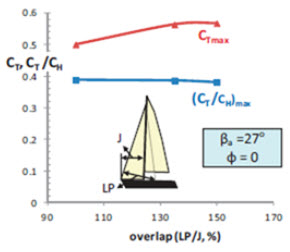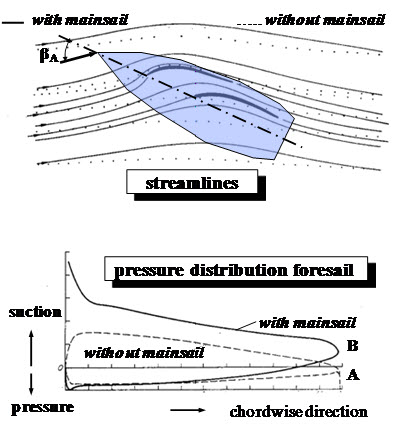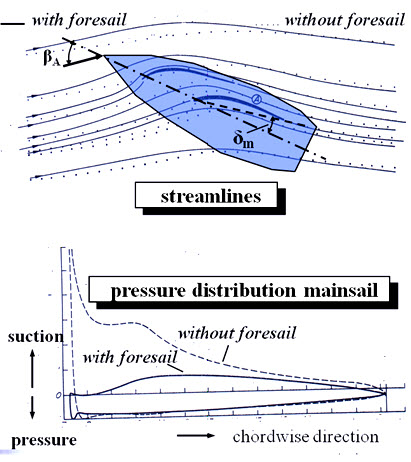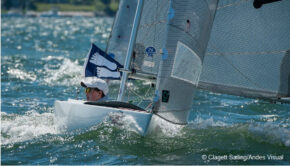Taking a deep dive into sail slots
Published on October 6th, 2021
In his book The Science behind Sailing, Dutch scientist Joop Slooff explains in detail the aero- and hydromechanics of sailing, providing full and scientifically justified descriptions of why boats sail.
Sloof, who also wrote about his involvement with the design of the infamous winged keel of 1983 America’s Cup winner Australia II, was inspired to expand on a recent Scuttlebutt sail trim report regarding headsail inhaulers. Buckle up for this brain buster:
The article “Ins and Outs of Inhaulers” by Barry Hayes is interesting, but misleading, if not incorrect, as far as the explanation of the flow physics of interacting mainsails and headsails is concerned.
Many theories have been put forward to explain the perceived superiority of a rig with closely coupled fore- and mainsails. However, it wasn’t until the paper+) published by the late Arvel Gentry*) in 1971 that the mechanisms involved were fully understood.
As argued by Gentry, the interaction between a mainsail and a foresail is governed by two different mechanisms. The first is the up/downwash that is generated by each of the sails. The second is an increased velocity of the flow near the trailing edge (leech) of the foresail. Figure 1 illustrates what is meant.
Shown, schematically, is the flow about a lifting sail section (solid black line) at a small angle of attack. As discussed in more detail in aerodynamic text books, the presence of a lifting airfoil (sail) causes upwash upstream and downwash downstream of the section. In addition a region with locally high flow velocity is formed on and above the suction side of the section, just aft of the leading edge.
When another sail section (foresail, dashed black line) is placed in front of the first section, it experiences the upwash induced by the first (mainsail) section as a virtual increase of the angle of attack. The variation of the induced upwash in the streamwise direction is experienced by the foresail as a virtual increase of camber, in particular towards its trailing edge.
———–
+) Gentry, A., ‘The Aerodynamics of Sail Interaction’, paper presented at the ‘Ancient Interface III’, 3rd AIAA Symposium on Sailing, November 1971, Redondo Beach, California
*) Arvel Gentry, aerodynamicist and yachtsman (like this author), was, at the time, working as a research scientist at the former Douglas Aircraft Company in Long Beach, California. His boss, A.M.O. Smith, a well-known fluid dynamicist, was to publish, in 1975, a hall-mark paper7.35 on the aerodynamics of aircraft wings with high lift devices at the leading and trailing edge. The Smith paper describes the mechanisms involved, which are very similar to the mechanisms involved with sails, in substantial detail.
———–
When the trailing edge of the foresail is positioned in the high flow velocity area at a small distance aft of and above the leading edge of the mainsail, which is the case when the sails are sheeted for ‘upwind’ conditions, even more circulation (resulting in more lift) is required to satisfy the condition of smooth and tangent flow detachment at the trailing edge.
In addition, the boundary layer on the foresail experiences a higher trailing edge ‘dumping velocity’. That is, it detaches from the trailing edge of the foresail with a higher velocity than the freestream velocity.
As shown in Figure 2, this implies (cf. Bernoulli’s Law) that the pressure at the trailing edge of the foresail is lower (level ‘B’) than without the presence of the mainsail (level ‘A’). As a positive, consequence separation of the boundary layer on the upper surface of the foresail is postponed to higher levels of lift.
In other words, the foresail can carry more lift when it is in the proximity of the mainsail. In summary, one can say that a foresail in the presence of a mainsail is forced to carry more lift through the upwash induced by the mainsail and that its boundary layer can sustain this higher level of lift by the higher ‘dumping velocity’/ lower pressure at the trailing edge.
The other side of the picture is that the mainsail operates in the field of downwash induced by the foresail. This is experienced by the mainsail as a smaller angle of attack but also as some increase of camber, in particular near the leading edge.
Figure 3 shows the effect on the pressure of the mainsail. Because of the reduction of the perceived angle of attack and the increased camber near the leading edge the mainsail carries less lift in the presence of the foresail, in particular near the leading edge.
An additional aspect is that the foresail acts as a sort of ‘flow directing device’ for the mainsail. Because the flow always leaves the leech of the foresail in the direction of the section slope at the trailing edge, the effective angle of attack of the mainsail hardly varies when, for fixed sheeting angles, the geometrical angle of attack of the combination (apparent wind angle) is varied.
As a consequence, the lift of the mainsail hardly varies when the apparent wind angle is increased or decreased. This means that most of the variation with angle of attack (apparent wind angle) of the lift and drag of the sail combination takes place on the foresail.
Therefore, the function of an in/outhaul or barber hauler is to have more control over the width of the gap between the foresail and the mainsail and the sheeting angle of the foresail. What this, and the effect of overlap, means for the forces (lift and drag) acting on the respective sails is described in detail in the book, The Science behind Sailing.
Editor’s note: With some trepidation, we asked Joop how the amount of overlap between foresail and mainsail impacts the variables, to which he replied:
 Increasing the overlap increases both lift and drag (not surprising of course because of the increased sail area). In terms of driving force this means that the maximum driving force is increased (important for reaching). There is, however, hardly any effect on the driving-force /heeling-force ratio (important for beating upwind). See figure to right.
Increasing the overlap increases both lift and drag (not surprising of course because of the increased sail area). In terms of driving force this means that the maximum driving force is increased (important for reaching). There is, however, hardly any effect on the driving-force /heeling-force ratio (important for beating upwind). See figure to right.
This means that there is no point in sailing with a foresail with overlap in high wind speeds and at very small apparent wind angles. However, overlap does pay for low to moderate wind speeds and larger apparent wind angles, provided that the overlap does not exceed about 45%.











 We’ll keep your information safe.
We’ll keep your information safe.